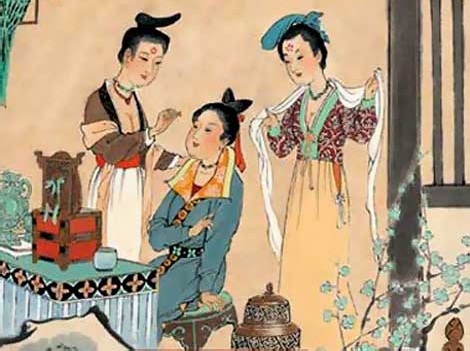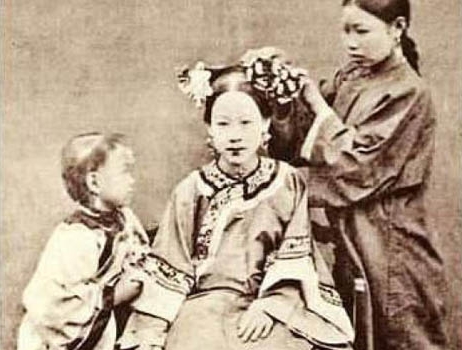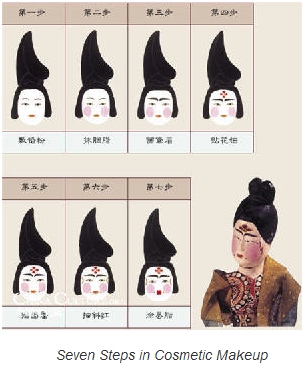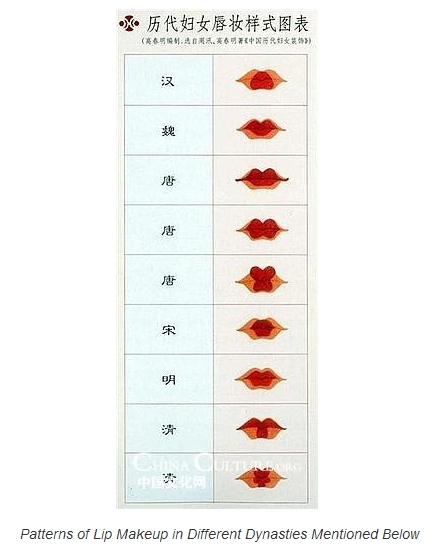

The shiny image of Zhang Ziyi in the movie the Banquet is impressive to many audiences. Her red and bright lips, short and dark eyebrows, and well decorated cheeks are the typical elements in the makeup popularized during the Tang Dynasty (AD 618—AD907).
In ancient China, especially in the Tang Dynasty, there were seven steps in cosmetic makeup for the belles: powder base, applying color to the face, eye-brow darkening, applying "forehead gold" or "floral twinkle/gold", painting the dimples, decorating the cheeks and applying lip color.
If eyes are the window to the soul, lips are the mirrors of one's character and temperament. Being an important part of face decoration as shown above, lip makeup enjoys a long history and has various patterns in different periods.

The Invention of Makeup for Lips in China
Before the Qin Dynasty (221 BC — 206 BC), the beauty of women's lips had already been paid special attention to. This was proven when in 1983, a life-size head statue of a goddess was excavated from Niu He Liang Hongshan Culture Site which has a history of over 5000 years, whose lips were red. This shows that the act of reddening lips has already appeared around 5,000 years ago in ancient China.
It is believed that lip makeup was originally practiced to please the gods in religious occasions. As time passed by, people realized that it could liven up one's spirit and sometimes even could reveal one's social status. As an consequence, different materials for lip beauty products were constantly tested and used to make the lips red and bright, creating the Chinese art of lip makeup.
The lip beauty products in ancient China were normally called "lip balm" or "mouth balm", as recorded by the Chinese dictionary Shiming (or: Explanation of Names) written by Liu Xi in the Eastern Han Dynasty (AD25—AD220).
It should be pointed out that, in its early stage, as with most other types of makeup, lip balm was typically, but not exclusively, worn by women. This paste-like and sticky mixture was applied to relieve chapped or dry lips caused by dry air, cold temperatures or wind. The primary purpose of lip balm is to provide a layer on the lip surface to seal moisture in, protecting them from external exposure.
The Production of Lip Balm
In prehistoric times, the pigments for lip beauty products were generally obtained from plant juices, animal bloods, or minerals.
During historic times, the raw material was vermilion, whose chemical composition is mercuric sulfide (HgS). It was produced in Hunan, Guizhou and Sichuan Province and bears the perfect color for ideal lips. However, lacking strong adhesion, vermilion is easily dissolved on warm lips so its shiny red could not last long. Therefore, later on, the ancient people added mineral wax and animal fat, making vermilion water-proof with strong adhesive force.
Besides vermilion, some ancient Chinese used rouge—the red facial balm (named "Yan Zhi" in Chinese) to do lip makeup.
The early lip balm was not like the lipstick we see today, but was a paste held in a particular container. After Sui (AD 589 — AD 618) and Tang Dynasties, some lip balm was processed into solid substance, tubular in shape. Being handy, this new type soon gained popularity. The production of lip balm has not undergone great renovation only until modern times.
The lip balm in ancient China also bore fantastic fragrance. In the North Dynasty (AD 386—AD 581) raw materials included ageratum and clove. In the Tang Dynasty, artificial flavors were added to the lip balm.
Various Patterns of Lip Makeup in Chinese History

Between Pre-Qin ( The 21st Century BC—221 BC) and Han (202BC-220AD) Dynasties, instead of applying lip balm to all parts of the lips, women put a big red dot on the lower lip and painted the upper lip in a pointed shape, leaving the rest of parts to be covered with powder.
In Wei, Jin, and North and South Dynasties (AD220—AD589), fan-shaped lips were advocated. Women made an obvious depression on the upper lip and lip contour in the corners of the mouth clear.
In Sui and Tang Dynasties, a florid style of lip makeup gained popularity. Women first put powder onto the lips, and then they drew any pattern they liked. During that period, cherry lips (lips with the shape and color of a cherry) were very popular. Two dots were usually painted outside the corner of the lips to strengthen the image of dimples. Another famous pattern took the shape of a little flower. To make it, women first made an obvious depression in the middle of the upper lip. Then the upper lip contour took the shape of two petals, and the lower lip another petal.
In the late Tang Dynasty, other patterns for lip makeup were also invented. According to the book Records of the Unworldly and the Strange, there were 17 patterns in the last 30 years of Tang. The color of red for lips included red, light red, red with golden powder, pink and so on.
In the Song (AD960—AD1279) and Ming (AD1368—AD1644) Dynasties, lip makeup was practiced to make women look more internalized and gentle. Cherry lips were also highly welcomed.
In the Qing Dynasty (AD1644—AD1911), women normally applied rouge to the whole or nearly whole upper lip, while they painted a cherry-like dot in the middle of the lower lip. Some women dotted in the middle of the two lips respectively.
In late Qing Dynasty, the whole society regarded Lin Daiyu as the beauty icon, who is a household character in the Chinese novel Dream of the Red Chamber, beautiful but fragile emotionally and physically. This fancy for morbid beauty lasted for a while till the period of the Republic of China.
Although both ancient and contemporary Chinese women mainly employed red for the lips, there is a black "tear makeup" which gained popularity in the Yuanhe years of the Tang Dynasty (AD806—AD820). Black balm was applied to the lips, producing a seemingly crying sad face. Failing to satisfy aesthetic sensibilities of many people, this tear makeup went out of fashion shortly after.
To express their sentimental attachment and pout to the men, some women left their lip marks with different shapes, colors and fragrances on men's necks and clothes, making the meeting some time ago unforgettable. This activity was mentioned in many Chinese ancient poems.





